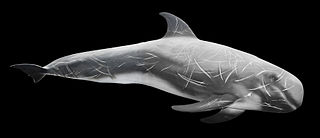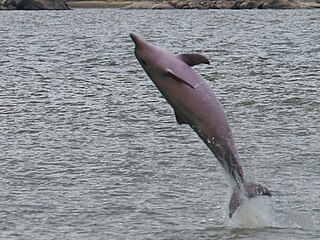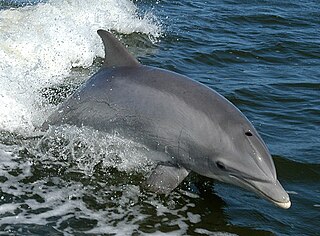Related Research Articles

The blue whale is a marine mammal belonging to the baleen whale parvorder Mysticeti. Reaching a maximum confirmed length of 29.9 metres (98 ft) and weighing up to 199 tonnes, it is the largest animal known to have ever existed. The blue whale's long and slender body can be various shades of greyish-blue dorsally and somewhat lighter underneath.

Mammals are a group of vertebrates constituting the class Mammalia, characterized by the presence of mammary glands which in females produce milk for feeding (nursing) their young, a neocortex, fur or hair, and three middle ear bones. These characteristics distinguish them from reptiles from which they diverged from in the Carboniferous, over 300 million years ago. Around 6,400 extant species of mammals have been described. The largest orders are the rodents, bats and Eulipotyphla. The next three are the Primates, the Artiodactyla, and the Carnivora.

The Sirenia, commonly referred to as sea-cows or sirenians, are an order of fully aquatic, herbivorous mammals that inhabit swamps, rivers, estuaries, marine wetlands, and coastal marine waters. The Sirenia currently comprise two distinct families: Dugongidae and Trichechidae with a total of four species. The Protosirenidae and Prorastomidae families are extinct. Sirenians are classified in the clade Paenungulata, alongside the elephants and the hyraxes, and evolved in the Eocene 50 million years ago (mya). The Dugongidae diverged from the Trichechidae in the late Eocene or early Oligocene.

Marine mammals are aquatic mammals that rely on the ocean and other marine ecosystems for their existence. They include animals such as seals, whales, manatees, sea otters and polar bears. They are an informal group, unified only by their reliance on marine environments for feeding and survival.

River dolphins are a polyphyletic group of fully aquatic mammals that reside exclusively in freshwater or brackish water. They are an informal grouping of dolphins, which itself is a paraphyletic group within the infraorder Cetacea. Extant river dolphins are placed in two superfamilies, Platanistoidea and Inioidea. They comprise the extant families Platanistidae, Iniidae and Pontoporiidae. There are five extant species of river dolphins. River dolphins, alongside other cetaceans, belong to the clade Artiodactyla, with even-toed ungulates, and their closest living relatives the hippopotamuses, from which they diverged about 40 million years ago. Specific types of Dolphins can be pink.

Bottlenose dolphins are aquatic mammals in the genus Tursiops. They are common, cosmopolitan members of the family Delphinidae, the family of oceanic dolphins. Molecular studies show the genus definitively contains two species: the common bottlenose dolphin and the Indo-Pacific bottlenose dolphin. Others, like the Burrunan dolphin, may be alternately considered their own species or be subspecies of T. aduncus. Bottlenose dolphins inhabit warm and temperate seas worldwide, being found everywhere except for the Arctic and Antarctic Circle regions. Their name derives from the Latin tursio (dolphin) and truncatus for their characteristic truncated teeth.

Risso's dolphin is the only species of dolphin in the genus Grampus. It is commonly known as the Monk dolphin among Taiwanese fishermen. Some of the closest related species to these dolphins include: pilot whales, pygmy killer whales, melon-headed whales, and false killer whales.

Oceanic dolphins or Delphinidae are a widely distributed family of dolphins that live in the sea. Thirty extant species are described. They include several big species whose common names contain "whale" rather than "dolphin", such as the Globicephalinae. Delphinidae is a family within the superfamily Delphinoidea, which also includes the porpoises (Phocoenidae) and the Monodontidae. River dolphins are relatives of the Delphinoidea.

The strap-toothed beaked whale, also known as Layard's beaked whale, is one of the largest members of the mesoplodont family, growing to 6.2 metres (20 ft) in length and reaching up to 1,300 kilograms (2,900 lb). The common and scientific name was given in honor of Edgar Leopold Layard, the curator of the South African Museum, who prepared drawings of a skull and sent them to the British taxonomist John Edward Gray, who described the species in 1865.

The tucuxi, alternatively known in Peru bufeo gris or bufeo negro, is a species of freshwater dolphin found in the rivers of the Amazon basin. The word tucuxi is derived from the Tupi language word tuchuchi-ana, and has now been adopted as the species' common name. Despite being found in geographic locations similar to those of 'true' river dolphins such as the boto, the tucuxi is not closely related to them genetically. Instead, it is classed in the oceanic dolphin family (Delphinidae).

Dall's porpoise is a species of porpoise endemic to the North Pacific. It is the largest of porpoises and the only member of the genus Phocoenoides. The species is named after American naturalist W. H. Dall.

Shepherd's beaked whale, also commonly called Tasman's beaked whale or simply the Tasman whale, is a cetacean of the family Ziphiidae. The whale has not been studied extensively. Only four confirmed at sea sightings have been made and 42 strandings recorded. It was first known to science in 1937, being named by W. R. B. Oliver after George Shepherd, curator of the Wanganui Museum, who collected the type specimen near Ohawe on the south Taranaki coast of New Zealand's North Island, in 1933.

The common bottlenose dolphin or Atlantic bottlenose dolphin is a wide-ranging marine mammal of the family Delphinidae. The common bottlenose dolphin is a very familiar dolphin species due to the wide exposure it receives in captivity in marine parks and dolphinaria, and in movies and television programs. It is the largest species of the beaked dolphins. It inhabits temperate and tropical oceans throughout the world, and is absent only from polar waters. While formerly known simply as the bottlenose dolphin, this term is now applied to the genus Tursiops as a whole. These dolphins inhabit warm and temperate seas worldwide. As considerable genetic variation has been described among members of this species, even between neighboring populations, many experts consider that additional species may be recognized.

The Clymene dolphin, in older texts known as the short-snouted spinner dolphin, is a dolphin endemic to the Atlantic Ocean. It is the only confirmed case of hybrid speciation in marine mammals, descending from the spinner dolphin and the striped dolphin.

Aonyx is a genus of otters, containing three species, the African clawless otter, the Congo clawless otter, and the Asian small-clawed otter. The word aonyx means "clawless", derived from the prefix a- ("without") and onyx ("claw/hoof").
The effect of climate change on marine life and mammals is a growing concern. Many of the effects of global warming are currently unknown due to unpredictability, but many are becoming increasingly evident today. Some effects are very direct such as loss of habitat, temperature stress, and exposure to severe weather. Other effects are more indirect, such as changes in host pathogen associations, changes in body condition because of predator–prey interaction, changes in exposure to toxins and CO2 emissions, and increased human interactions. Despite the large potential impacts of ocean warming on marine mammals, the global vulnerability of marine mammals to global warming is still poorly understood.

The southern elephant seal is one of two species of elephant seals. It is the largest member of the clade Pinnipedia and the order Carnivora, as well as the largest extant marine mammal that is not a cetacean. It gets its name from its massive size and the large proboscis of the adult male, which is used to produce very loud roars, especially during the breeding season. A bull southern elephant seal is about 40% heavier than a male northern elephant seal, twice as heavy as a male walrus, and 6–7 times heavier than the largest living mostly terrestrial carnivorans, the polar bear and the Kodiak bear ,.

Artiofabula is a clade made up of the Suina and the Cetruminantia. The clade was found in molecular phylogenetic analyses and contradicted traditional relationships based on morphological analyses.

The harbourseal, also known as the common seal, is a true seal found along temperate and Arctic marine coastlines of the Northern Hemisphere. The most widely distributed species of pinniped, they are found in coastal waters of the northern Atlantic, Pacific Oceans, Baltic and North Seas.
References
- ↑ Benton, Michael J. (2008-11-27). The History of Life: A Very Short Introduction. OUP Oxford. pp. 150–. ISBN 9780199226320.
- ↑ Bernd Würsig; J.G.M. Thewissen; Kit M. Kovacs (27 November 2017). Encyclopedia of Marine Mammals. Elsevier Science. ISBN 978-0-12-804381-3.